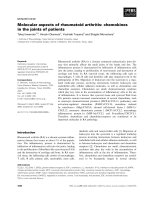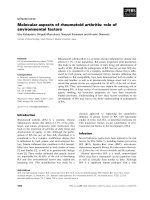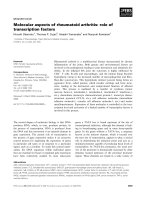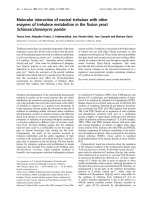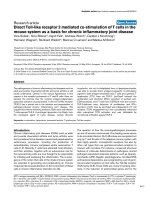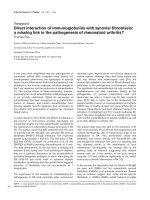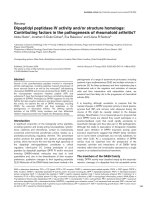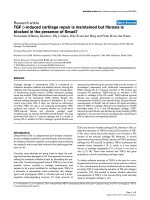Báo cáo y học: "Direct interaction of immunoglobulins with synovial fibroblasts: a missing link in the pathogenesis of rheumatoid arthritis" potx
Bạn đang xem bản rút gọn của tài liệu. Xem và tải ngay bản đầy đủ của tài liệu tại đây (39.74 KB, 3 trang )
44
IGF-R1 = insulin growth factor receptor 1; IL = interleukin; OASF = osteoarthritis synovial fibroblast; RA = rheumatoid arthritis; RASF = rheumatoid
arthritis synovial fibroblast.
Arthritis Research & Therapy Vol 7 No 1 Pap
It has been well established that the pathogenesis of
rheumatoid arthritis (RA) comprises three distinct but
interdependent phenomena: the hyperplasia of synovial
tissue, chronic inflammation (both local and systemic), and
alterations in the immune response, including changes in
the T-cell repertoire and the production of autoantibodies
[1]. The precise nature of these interactions, however,
particularly the role of autoantibodies in RA pathogenesis,
is not yet fully understood. Whilst the occurrence of
autoantibodies has been recognised as a characteristic
feature of disease, and certain autoantibodies have
become valuable tools for diagnosis, their contribution to
the initiation and perpetuation of disease has remained
largely elusive.
A recent article by Terry Smith and William Cruikshank in
the Journal of Immunology provides fascinating yet
unexpected insights into how autoantibodies contribute to
the maintenance of inflammatory disease processes in RA
[2]. The authors report that IgG antibodies from the sera
of patients with RA (RA-IgG) can stimulate RA synovial
fibroblasts (RASFs) through interaction with insulin-like
growth factor receptor 1 (IGF-R1). This interaction of RA-
IgG with IGF-R1 increases the production of IL-16 and
RANTES in RASFs provoking chemoattraction of T cells.
The data demonstrate, for the first time, a bridging link
between B-cell activity and T-cell trafficking. In addition,
they are of potential importance for the development of
innovative therapeutic strategies, in which interrupting the
IGF-1/IGF-1R axis could result in sustained disease
modification by affecting both the growth-factor triggered
activation of fibroblasts and the accumulation of T
lymphocytes.
The significance of this research for understanding the
pathogenesis of RA (and potentially other autoimmune
disorders) goes beyond these two obvious aspects for
several reasons. Although there have been reports that
IgG may interact with mesenchymal cells [3-5], the
present data establish a new role for (B-cell derived) auto-
antibodies in the pathogenesis of autoimmune disease.
The hypothesis that autoantibodies not only constitute an
epiphenomenon but also contribute directly to the
pathogenesis of synovial inflammation and joint
destruction has seen a ‘revival’ over the last couple of
years [6,7]. This is mainly due to the observation that
passive transfer of serum or immunoglobulins from arthritic
K/BxN mice to healthy animals can cause arthritis [8, 9].
However, these effects have been attributed mainly to the
activation of complement and Fc-γ receptor pathways [6],
and it has been suggested that, at a cellular level, mast
cells link the autoantibodies to soluble mediators as well
as to other effectors in arthritis [10].
The present data shed new light on the interaction of B-
cells (more precisely B-cell derived immunoglobulins) and
resident fibroblast-like cells of mesenchymal origin in the
perpetuation of RA. They demonstrate clearly that
antibodies may interact directly with fibroblast-like cells
and through this interaction form part of a signalling loop
that ultimately results in the maintenance of local
inflammation. Consequently, the findings add to the
growing body of evidence suggesting that resident
stromal cells are a key element of the local immune
response [11] and contribute significantly to the switch
from acute to chronic inflammation in RA [12].
In this context, the observation that the effects of RA-IgG
are seen with RASFs but not osteoarthritis synovial
fibroblasts (OASFs) is of particular importance. Several
lines of evidence suggest that, unlike normal synovial
fibroblasts or OASFs, RASFs exhibit features of stable
Viewpoint
Direct interaction of immunoglobulins with synovial fibroblasts:
a missing link in the pathogenesis of rheumatoid arthritis?
Thomas Pap
Division of Molecular Medicine of Musculoskeletal Tissue, University Hospital Münster, Germany
Corresponding author: Thomas Pap,
Published: 20 December 2004
Arthritis Res Ther 2005, 7:44-46 (DOI 10.1186/ar1493)
© 2004 BioMed Central Ltd
45
Available online />cellular activation (also known as transformation), that
leads to alteration in their apoptotic response, the
attachment of these cells to articular cartilage and
subsequently to the degradation of the cartilage matrix
[11, 13]. This notion has been derived from in vitro studies
as well as the SCID-mouse in vivo model of cartilage
destruction. Although a number of molecular pathways
have been identified that contribute to the stable activation
of RASFs, the precise cause and nature of this activation,
as well as its relevance and consequences, are matters of
debate. The present data indicate very clearly that stable
alterations in the fibroblasts themselves are indispensable
for (auto)antibodies to exert their effects on IL-16 (and
RANTES) mediated chemoattraction. It has to be
emphasised that the experiments were done with
fibroblasts that had been cultured for 3–10 passages in
vitro before being exposed to the immunoglobulins.
Consequently, the data suggest that the local stromal
environment in the joint (and based on previous data from
the group other organs as well [14]) to a large extent
determines the disease specific immune response. Given
the variety of signaling pathways initiated by IGF-1 in
fibroblasts, it may be speculated, as the authors mention
briefly, that binding of antibodies to IGF-1R exerts a
number of other, potentially disease relevant effects in
autoimmune diseases such as RA.
Finally, the paper draws our attention back to IL-16, a
cytokine that has been demonstrated at elevated levels in
the sera [15,16] and synovial fluids [17] of patients with
RA, but that has not been studied extensively in RA due to
controversial data on its role in the pathogenesis of
disease [18]. The present research on the interaction of
RA-IgG and RASFs as well as other recent data, however,
may change the picture. It has been reported by Huizinga
and colleagues that in a cohort of patients with recent
onset arthritis, patients who later developed RA showed
significantly higher serum levels of IL-16 than patients with
undifferentiated arthritis and that high IL-16 levels
correlated positively with the degree of joint destruction
over a 2-year period [16]. These data extend the
aforementioned observations and link IL-16 to the disease
process of RA. In this context it is of interest, that CD4
expression per se is not sufficient to mediate IL-16 effects
[19]. Rather, IL-16 mediated T cell migration appears to
be linked to CCR5, a receptor that is expressed
predominantly in Th1 cells and is physically associated
with CD4 [20]. RASFs have been identified as major
producers of IL-16 in the rheumatoid joint, and it has been
demonstrated that inflammatory cytokines present in the
RA synovium such as TNFα and IL-1β can upregulate IL-
16 in fibroblasts [21]. By demonstrating that in addition to
these cytokines, growth factor signals trigger the release
of IL-16 in RASFs, the present research from Smith and
Cruikshank extends the panel of signals involved in the
regulation of IL-16 at least under pathologic conditions.
Although the study does not explain why RASFs and
OASFs react differently to stimulation with RA-IgG, other
data suggest that the expression of IL-16 may be regulated
by different pathways in RASFs and OASFs [22].
Taken together, the data alter current concepts of how the
immune system interacts with resident fibroblast-like cells
and, even more intriguingly, add to the notion that
alterations in the local fibroblast environment determine
the specific immune response.
Competing interests
The author(s) declare that they have no competing interests.
References
1. Pap T, Gay RE, Gay S: Rheumatoid arthritis. In: The molecular
pathology of autoimmune diseases. 2nd ed. Edited by The-
ofilopoulos AN, Bona CA. New York: Taylor & Francis; 2002: 376-
401.
2. Pritchard J, Tsui S, Horst N, Cruikshank WW, Smith TJ: Synovial
fibroblasts from patients with rheumatoid arthritis, like fibrob-
lasts from Graves’ disease, express high levels of IL-16 when
treated with Igs against insulin-like growth factor-1 receptor. J
Immunol 2004,173:3564-3569.
3. O’Toole EA, Mak LL, Guitart J, Woodley DT, Hashimoto T, Amagai
M, Chan LS: Induction of keratinocyte IL-8 expression and
secretion by IgG autoantibodies as a novel mechanism of epi-
dermal neutrophil recruitment in a pemphigus variant. Clin
Exp Immunol 2000,119:217-224.
4. Heufelder AE, Bahn RS: Graves’ immunoglobulins and
cytokines stimulate the expression of intercellular adhesion
molecule-1 (ICAM-1) in cultured Graves’ orbital fibroblasts.
Eur J Clin Invest 1992, 22:529-537.
5. Rotella CM, Zonefrati R, Toccafondi R, Valente WA, Kohn LD.
Ability of monoclonal antibodies to the thyrotropin receptor to
increase collagen synthesis in human fibroblasts: an assay
which appears to measure exophthalmogenic immunoglobu-
lins in Graves’ sera. J Clin Endocrinol Metab 1986,62:357-367.
6. Benoist C, Mathis D: A revival of the B cell paradigm for
rheumatoid arthritis pathogenesis? Arthritis Res 2000, 2:90-94.
7. Steiner G, Smolen J: Autoantibodies in rheumatoid arthritis
and their clinical significance. Arthritis Res 2002, 4:S1-5.
8. Korganow AS, Ji H, Mangialaio S, Duchatelle V, Pelanda R, Martin
T, Degott C, Kikutani H, Rajewsky K, Pasquali JL, Benoist C,
Mathis D: From systemic T cell self-reactivity to organ-specific
autoimmune disease via immunoglobulins. Immunity
1999,10:451-461.
9. Matsumoto I, Staub A, Benoist C, Mathis D: Arthritis provoked
by linked T and B cell recognition of a glycolytic enzyme.
Science 1999, 286:1732-1735.
10. Lee DM, Friend DS, Gurish MF, Benoist C, Mathis D, Brenner
MB: Mast cells: a cellular link between autoantibodies and
inflammatory arthritis. Science 2002, 297:1689-1692.
11. Pap T, Muller-Ladner U, Gay RE, Gay S: Fibroblast biology. Role
of synovial fibroblasts in the pathogenesis of rheumatoid
arthritis. Arthritis Res 2000, 2:361-367.
12. Buckley CD, Pilling D, Lord JM, Akbar AN, Scheel-Toellner D,
Salmon M: Fibroblasts regulate the switch from acute resolv-
ing to chronic persistent inflammation. Trends Immunol 2001,
22:199-204.
13. Firestein GS: Evolving concepts of rheumatoid arthritis. Nature
2003, 423:356-361.
14. Pritchard J, Horst N, Cruikshank W, Smith TJ: Igs from patients
with Graves’ disease induce the expression of T cell chemoat-
tractants in their fibroblasts. J Immunol 2002,168:942-950.
15. Kaufmann J, Franke S, Kientsch-Engel R, Oelzner P, Hein G, Stein
G: Correlation of circulating interleukin 16 with proinflamma-
tory cytokines in patients with rheumatoid arthritis. Rheuma-
tology 2001, 40:474-475.
16. Lard LR, Roep BO, Toes RE, Huizinga TW: Enhanced concentra-
tions of interleukin 16 are associated with joint destruction in
patients with rheumatoid arthritis. J Rheumatol 2004, 31:35-39.
46
Arthritis Research & Therapy Vol 7 No 1 Pap
17. Franz JK, Kolb SA, Hummel KM, Lahrtz F, Neidhart M, Aicher WK,
Pap T, Gay RE, Fontana A, Gay S: Interleukin-16, produced by
synovial fibroblasts, mediates chemoattraction for CD4+ T
lymphocytes in rheumatoid arthritis. Eur J Immunol 1998, 28:
2661-2671.
18. Klimiuk PA, Goronzy JJ, Weyand CM: IL-16 as an anti-inflamma-
tory cytokine in rheumatoid synovitis. J Immunol 1999, 162:
4293-4299.
19. Mathy NL, Bannert N, Norley SG, Kurth R: Cutting edge: CD4 is
not required for the functional activity of IL-16. J Immunol
2000, 164:4429-4432.
20. Lynch EA, Heijens CA, Horst NF, Center DM, Cruikshank WW:
Cutting edge: IL-16/CD4 preferentially induces Th1 cell
migration: requirement of CCR5. J Immunol 2003, 171:4965-
4968.
21. Sciaky D, Brazer W, Center DM, Cruikshank WW, Smith TJ: Cul-
tured human fibroblasts express constitutive IL-16 mRNA:
cytokine induction of active IL-16 protein synthesis through a
caspase-3-dependent mechanism. J Immunol 2000, 164:
3806-3814.
22. Weis-Klemm M, Alexander D, Pap T, Schutzle H, Reyer D, Franz
JK, Aicher WK: Synovial fibroblasts from rheumatoid arthritis
patients differ in their regulation of IL-16 gene activity in com-
parison to osteoarthritis fibroblasts. Cell Physiol Biochem
2004, 14:293-300.
